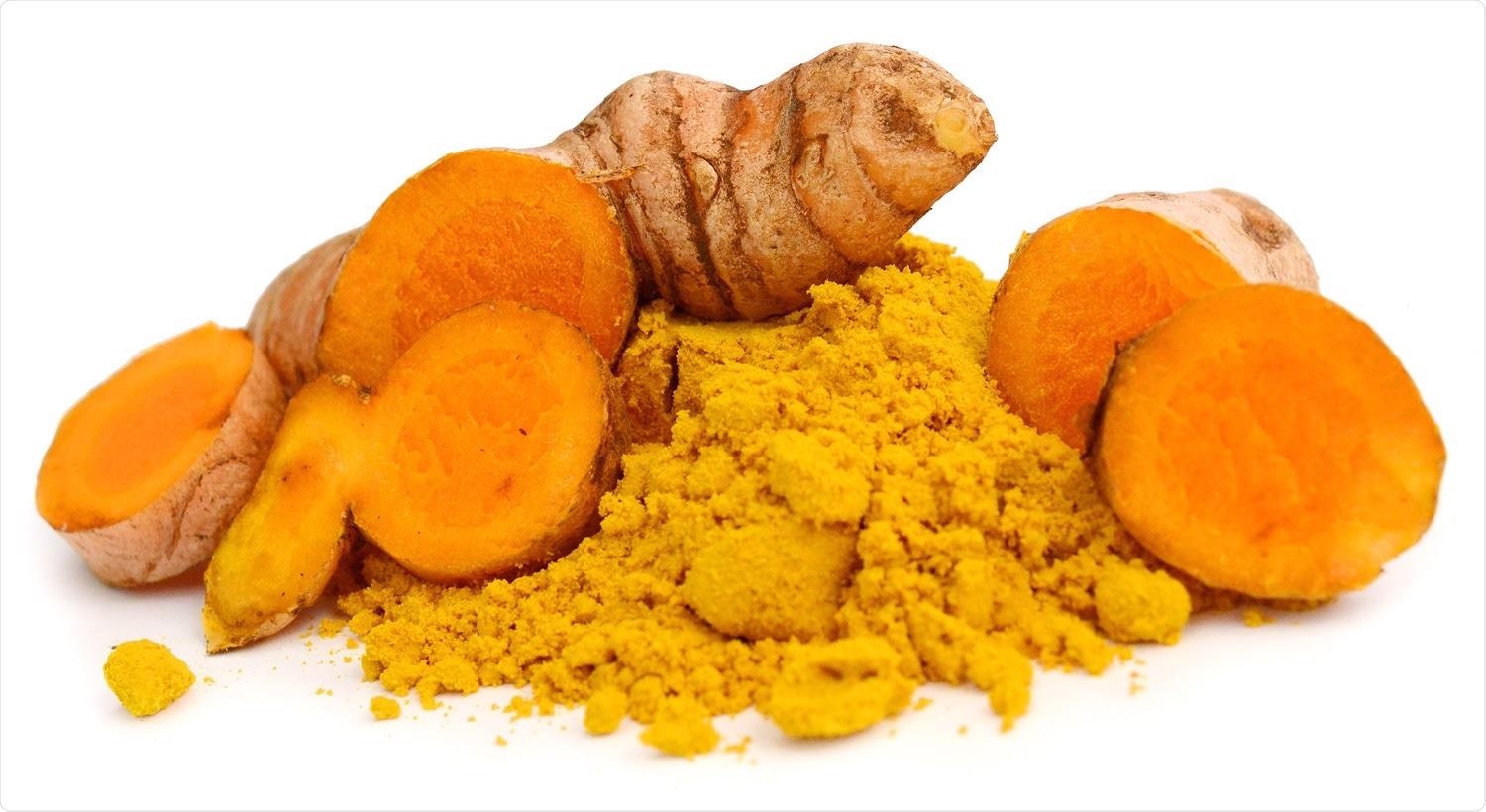The multi-organ failure, lung injury, and poor prognosis of severe disease in coronavirus disease 2019 (COVID-19) patients are directly associated with the interleukin (IL)-induced profound cytokine storm developed in response to SARS-CoV-2 infection in these patients. The interaction between SARS-CoV-2 and human angiotensin-converting enzyme 2 (hACE2) receptors triggers the cytokine storm followed by life-threatening systemic inflammatory responses. The fatal inflammatory syndrome is characterized by higher circulating cytokine levels and immune cell hyperactivation, leading to secondary organ dysfunction, especially hepatic, pulmonary, or renal.
A dietary polyphenolic antioxidant compound named CUR obtained from turmeric plant Curcuma longa L. is famous for its robust anti-inflammatory activity. However, in vivo efficacy of CUR is constrained because of its inadequate bioavailability.
 Study: Nanocurcumin Potently Inhibits SARS-CoV-2 Spike Protein-Induced Cytokine Storm by Deactivation of MAPK/NF-κB Signaling in Epithelial Cells. Image Credit: COLOA Studio / Shutterstock
Study: Nanocurcumin Potently Inhibits SARS-CoV-2 Spike Protein-Induced Cytokine Storm by Deactivation of MAPK/NF-κB Signaling in Epithelial Cells. Image Credit: COLOA Studio / Shutterstock
About the study
In the present study, the authors compared the anti-inflammatory effect of CUR−PS-NPs directed towards CoV2-SP-stimulated cytokine storm with bulk-CUR (B-CUR) and PS-NPs in lung and liver epithelial cells. Further, the researchers interpreted the mechanism associated with the inhibition of nuclear factor κB (NF-κB) signaling and mitogen-activated protein kinase (MAPK) deactivation by CUR that inhibited the CoV2-SP-mediated cytokine storms. The team also evaluated the function of CUR in lowering CoV2-SP-induced phosphorylation of p42/44 MAPK, p65/NF-κB, p38 MAPK, and nuclear p65/NF-κB expression, and release of growth factors, chemokines, and cytokines associated with the lung and liver epithelial cell injury.
CUR (97% purity), purified biotinylated recombinant hACE2, and SARS-CoV-2 S recombinant glycoproteins were used in this study. Further, the liver Huh7.5 and lung A549 epithelial cells were procured from the American Type Culture Collection (ATCC)-recognized cell repository at National Centre for Cell Sciences, Pune, India.
The PS-rich fraction was isolated and characterized from the dried rhizomes of C. longa. An emulsion solvent evaporation technique with minor changes was used in the CUR−PS-NPs' preparation. The epithelial cells were seeded and incubated with CoV2-SP containing stock solution.
The total ribonucleic acid (RNA) was isolated from the CoV2-SP-exposed epithelial cell pallets using an RNeasy mini kit. Subsequently, reverse transcription-quantitative polymerase chain reaction (RT-qPCR) experiments were conducted in the genes of CoV2-SP-exposed and unexposed epithelial cells. The interaction between CoV2-SP and hACE2 was assessed by enzyme-linked immunosorbent assay (ELISA). The cell viability was evaluated by the fluorescence-activated cell sorting (FACS) analysis, fluorescence microscopy, and Alamar blue assay using propidium iodide (PI) and Annexin V-FITC.
Study findings
The results indicated that the size of the CUR−PS-NPs was within the nanomaterial range, and there was a continuous CUR release from the CUR–PS-NPs.
CUR–PS-NPs showed a high potential to inhibit the release of chemokines such as IP10, MCP-1, and CXCL8, growth factors such as vascular endothelial growth factor (VEGF) and C-C chemokine ligand 3 (CCL3), and cytokines such as IL-12, IL-6, and IL-1 associated with the impairment of CoV2-SP-triggered lung A549 and liver Huh7.5 epithelial cells.
The inhibition of chemokines, cytokines, and growth factors by CUR–PS-NPs in A549 and Huh7.5 cells was higher than PS-NPs and B-CUR-treated cells. However, the inhibition of VEGF-A, CCL10, and CCL5 in PS-NPs and B-CUR-treated A549 cells were higher than the CUR–PS-NPs-treated cells. No significant inhibitory effects on the release of IL-8 and IL-6 in CoV2-SPs-triggered Huh7.5 and A549 cells were demonstrated by the PS-NPs treatment alone.
Therapeutical strategies employing CUR–PS-NPs successfully diminished the interaction between CoV2-SP and host ACE2. CUR−PS-NPs’ potential to inhibit the interaction of CoV2-SP and human ACE2 was higher than that of PS-NPs and B-CUR.
At the 10 μM dose, both B-CUR and nano-CUR caused significant reductions in cell viability whereas, at the 5 μM dose, neither B-CUR nor nano-CUR caused any lethality to the cells. Additionally, nano-CUR had superior bioavailability than B-CUR.
CUR-PS-NPs act by lowering NF-κB/MAPK signaling, resulting in the reduction of CoV2-SP-induced phosphorylation of p65/NF-κB, p38 MAPK, p65/NF-κB, and p42/44 MAPK expression. The reduction of CoV2-SP-induced phosphorylation of protein kinases caused by CUR-PS-NPs was higher than B-CUR-induced reductions.
Conclusions
The study findings indicated that organic NPs of CUR obtained from a PS-affluent fraction of turmeric rhizome, CUR−PS-NPs, have a high inhibitory potential towards CoV2-SP-induced cytokine storm in human lung A549 and liver Huh7.5 epithelial cells. Furthermore, the treatment of CUR−PS-NPs in CoV2-SP-triggered epithelial cells prevented the epithelial cell damage by inhibiting the release of chemokines, growth factors, and cytokines through the deactivation of the NF-κB/MAPK signaling pathway.
Overall, the study emphasized that the CUR−PS-NPs might have the potential to become a safe and effective drug for COVID-19 treatment. However, additional in vivo investigations are needed to validate the CoV2-SP-induced cytokine storm inhibitory potential of CUR-PS-NPs in lung and liver epithelial cells.
Journal reference:
- Nanocurcumin Potently Inhibits SARS-CoV-2 Spike Protein-Induced Cytokine Storm by Deactivation of MAPK/NF-κB Signaling in Epithelial Cells, Vivek K. Sharma, Prateeksha, Shailendra P. Singh, Brahma N. Singh, Chandana V. Rao, and Saroj K. Barik, ACS Applied Bio Materials Article ASAP, DOI: 10.1021/acsabm.1c00874, https://pubs.acs.org/doi/10.1021/acsabm.1c00874